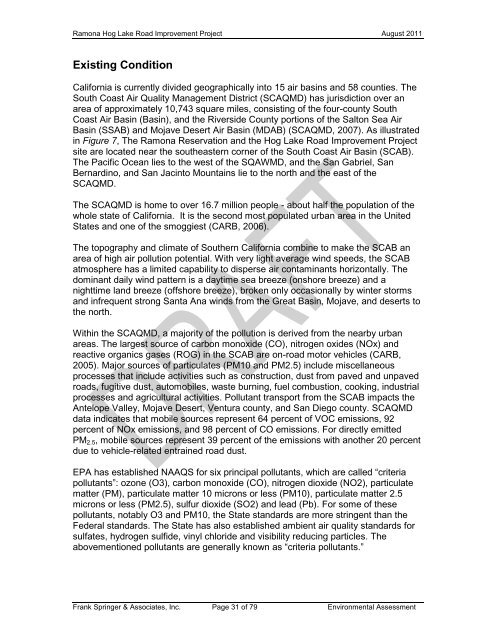environmental assessment for the hog lake road improvement project
environmental assessment for the hog lake road improvement project
environmental assessment for the hog lake road improvement project
Create successful ePaper yourself
Turn your PDF publications into a flip-book with our unique Google optimized e-Paper software.
Ramona Hog Lake Road Improvement Project August 2011<br />
Existing Condition<br />
Cali<strong>for</strong>nia is currently divided geographically into 15 air basins and 58 counties. The<br />
South Coast Air Quality Management District (SCAQMD) has jurisdiction over an<br />
area of approximately 10,743 square miles, consisting of <strong>the</strong> four-county South<br />
Coast Air Basin (Basin), and <strong>the</strong> Riverside County portions of <strong>the</strong> Salton Sea Air<br />
Basin (SSAB) and Mojave Desert Air Basin (MDAB) (SCAQMD, 2007). As illustrated<br />
in Figure 7, The Ramona Reservation and <strong>the</strong> Hog Lake Road Improvement Project<br />
site are located near <strong>the</strong> sou<strong>the</strong>astern corner of <strong>the</strong> South Coast Air Basin (SCAB).<br />
The Pacific Ocean lies to <strong>the</strong> west of <strong>the</strong> SQAWMD, and <strong>the</strong> San Gabriel, San<br />
Bernardino, and San Jacinto Mountains lie to <strong>the</strong> north and <strong>the</strong> east of <strong>the</strong><br />
SCAQMD.<br />
The SCAQMD is home to over 16.7 million people - about half <strong>the</strong> population of <strong>the</strong><br />
whole state of Cali<strong>for</strong>nia. It is <strong>the</strong> second most populated urban area in <strong>the</strong> United<br />
States and one of <strong>the</strong> smoggiest (CARB, 2006).<br />
The topography and climate of Sou<strong>the</strong>rn Cali<strong>for</strong>nia combine to make <strong>the</strong> SCAB an<br />
area of high air pollution potential. With very light average wind speeds, <strong>the</strong> SCAB<br />
atmosphere has a limited capability to disperse air contaminants horizontally. The<br />
dominant daily wind pattern is a daytime sea breeze (onshore breeze) and a<br />
nighttime land breeze (offshore breeze), broken only occasionally by winter storms<br />
and infrequent strong Santa Ana winds from <strong>the</strong> Great Basin, Mojave, and deserts to<br />
<strong>the</strong> north.<br />
Within <strong>the</strong> SCAQMD, a majority of <strong>the</strong> pollution is derived from <strong>the</strong> nearby urban<br />
areas. The largest source of carbon monoxide (CO), nitrogen oxides (NOx) and<br />
reactive organics gases (ROG) in <strong>the</strong> SCAB are on-<strong>road</strong> motor vehicles (CARB,<br />
2005). Major sources of particulates (PM10 and PM2.5) include miscellaneous<br />
processes that include activities such as construction, dust from paved and unpaved<br />
<strong>road</strong>s, fugitive dust, automobiles, waste burning, fuel combustion, cooking, industrial<br />
processes and agricultural activities. Pollutant transport from <strong>the</strong> SCAB impacts <strong>the</strong><br />
Antelope Valley, Mojave Desert, Ventura county, and San Diego county. SCAQMD<br />
data indicates that mobile sources represent 64 percent of VOC emissions, 92<br />
percent of NOx emissions, and 98 percent of CO emissions. For directly emitted<br />
PM2.5, mobile sources represent 39 percent of <strong>the</strong> emissions with ano<strong>the</strong>r 20 percent<br />
due to vehicle-related entrained <strong>road</strong> dust.<br />
EPA has established NAAQS <strong>for</strong> six principal pollutants, which are called “criteria<br />
pollutants”: ozone (O3), carbon monoxide (CO), nitrogen dioxide (NO2), particulate<br />
matter (PM), particulate matter 10 microns or less (PM10), particulate matter 2.5<br />
microns or less (PM2.5), sulfur dioxide (SO2) and lead (Pb). For some of <strong>the</strong>se<br />
pollutants, notably O3 and PM10, <strong>the</strong> State standards are more stringent than <strong>the</strong><br />
Federal standards. The State has also established ambient air quality standards <strong>for</strong><br />
sulfates, hydrogen sulfide, vinyl chloride and visibility reducing particles. The<br />
abovementioned pollutants are generally known as “criteria pollutants.”<br />
Frank Springer & Associates, Inc. Page 31 of 79 Environmental Assessment
















